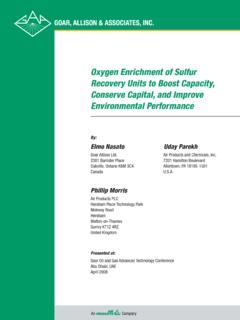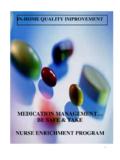Transcription of Enrichment Gone Wrong!
1 35 Enrichment gone Wrong! Valerie J. Hare, Beth Rich, and Karen E. WorleyThe Shape of Enrichment , Inc., San Diego, United States of America AbstractBy definition, an enriched environment offers more potential for harm than a sterile environment. Yet, the behavioral, physical, and welfare benefits of providing an enriched environment are generally considered to outweigh the risks and, thankfully, Enrichment efforts continue to increase worldwide. To further reduce risk, responsible caretakers make every reasonable effort to anticipate and prevent harm from occurring.
2 Regretfully, harm, and even death, have occurred as the direct result of providing Enrichment . But these events, and the details of the Enrichment involved, are rarely made public, presumably to avoid negative press and professional embarrassment. Unfortunately, reluctance to share this information may contribute to additional harmful outcomes. Information, even anecdotal, about the hazards of Enrichment can be invaluable to other animal-care professionals, as they design Enrichment plans and devices for their animals. This paper consists of a collection of anonymous, anecdotal accounts of Enrichment gone wrong presented in a safety-oriented context.
3 Introduction An enriched enclosure is inherently more dangerous than a sterile enclosure. Toys, furniture, manipulanda, vegetation, feeding devices, movable perching, substrates, indeed, virtually all Enrichment strategies offer a myriad of potential hazards. Yet, for our captive animals physical and psychological welfare, we are ethically (and sometimes legally) compelled to provide enriched enclosures. Hartley (2006) has compiled a useful review of the physical, behavioral, and psychological health issues that may be caused or exacerbated with Enrichment .
4 This paper will focus primarily on the physical dangers known to have occurred as a direct result of an Enrichment plan. The following three areas of safety concerns are discussed: (I) Animal and Cagemate; (II) Public and Staff; and (III) Escape and Keeper Access. All examples given are either from the authors personal experience or have been reported directly to the authors by individuals with first-hand knowledge of the incidents. I. Animal and Cagemate Safety ConcernsThe most obvious safety concern is for the animals themselves or their cagemate(s).
5 Animal hazards include ingestion, entanglement, suffocation, entrapment of body parts, tooth damage or impaction, and so on. Depending on the animal involved, any of these may require anesthesia and/or surgery to correct. Regrettably, some have resulted in an animal s death. Body Part Entrapment HolesExample 1. Fishing Cat and PVC TubeTo increase the difficulty of catching live fish by providing them a refuge, a PVC tube was added to the pond in a fishing cat (Felis viverrinus) enclosure. The tube was large enough in diameter to readily allow the cat s paws to move freely in and out of it.
6 However, the diameter was also large enough to allow the cat to insert his head but small enough that he became stuck (Fig. 1). The cat panicked and, in his attempts to push the tube off his head, severely damaged his claws. Fortunately, he was anesthetized and the tube was successfully removed. Although this cat recovered, death due to drowning or hyperthermia was considered a realistic outcome of this entrapment. 36 Example 2. Elephant and Truck TireMany elephant yards have suspended truck tires for the elephants to manipulate. Although one zoo had such a tire in the enclosure for years, one elephant managed to get her rear foot caught in the tire interior.
7 The elephant was clearly distressed as she tried to remove her foot. Although staff were aware of the problem immediately, they were unable to devise a plan to quickly extricate the elephant. Fortunately, the elephant was eventually able to free her foot. Example 3. Maned Wolf and Feeder BallA three-year-old male maned wolf (Chrysocyon brachyrus) received his overnight diet in a feeder ball. He was discovered the following morning with his lower jaw stuck in the hole (Fig. 2). He was anesthetized and the ball was successfully removed; the wolf escaped with mild lacerations.
8 TIP Hole SizeDuring initial and revising phases of design, be sure to consider hole sizes. Remember that holes must be either too large (so inserted body parts cannot become stuck, Fig. 3) or too small (to prevent insertion of body parts). Measurements taken during routine medical examinations can be helpful when determining appropriate sizes. If these measurements are not available, good approximations may be obtained from biofacts available in your zoo (Education Departments are a good source for these!). If, for example, you have access to a skull from the species you are interested in, you could measure its jaw size and add a few millimeters to accommodate the tissue on a living animal s jaw.
9 Approximations can be also be made from measurements from a similar species. Due to species, gender, and individual variations, hole size must be determined to be safe for each animal to receive this Enrichment . It is important to remember that juveniles and other cagemates, whether the intended user of an Enrichment item or not, will have access to most items placed in their enclosure. These individuals may vary greatly in size from the intended animal. The hole size must be safe for all individuals who may interact with the Enrichment , each item should be checked before every presentation to ensure that holes have not become enlarged, split, or have sharpened edges, etc.
10 (Fig. 4).TIP MaterialsThe maned wolf example (Ex. 3; ) above was not only a hole-size problem but also one of the material used. Soft, flexible rubber or plastic balls allow too much variability in size and shape to be safe in many situations. With a flexible ball, the hole size could change shape (with pressure) and allow the insertion of the lower jaw. Yet, once the pressure was removed, the hole size returned to normal and the jaw could not be , inflexible balls, such as a Boomer Balls , do not allow a change in hole shape or size. It is difficult to tell from the photo, but the hole size may actually have been sufficiently small to prevent the wolf s jaw from being Enrichment gone Wrong!






